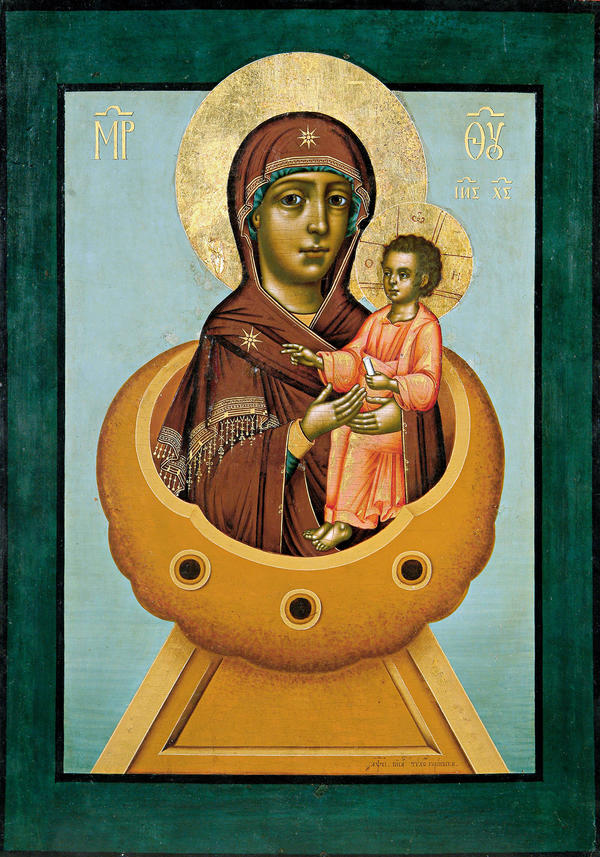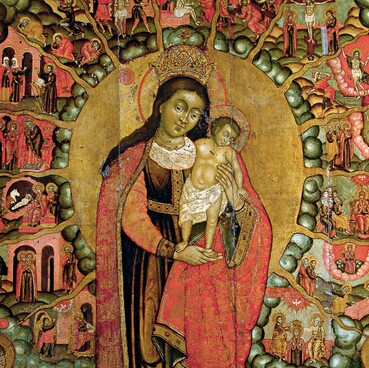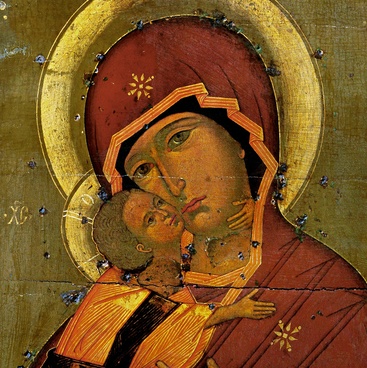The Virgin Life-Giving Spring was created by Tikhon Gorinsky in 1715. This image dates back to the miraculous icon that graced a temple near the Selevrian Gate (near Constantinople). The Byzantine temple was located close to a healing spring. The 14th century historian Nicephorus Callistus created a detailed description of the temple and the miraculous icon. According to this description, the icon depicted the afflicted that came to the icon hoping to be healed from their diseases.
The earliest images of the Virgin Life-Giving Spring date back to the 14th and 15th centuries. These images belong to a short version of iconography: they represent only the Mother of God with baby Jesus in the cup. Such images reminded not only of the healing help of the Mother of God, yet also had a deeper meaning associated with the theme of the Incarnation. Christianity understands the Incarnation as a source of salvation, which opens the way to eternal life.
The cup with the image of the Holy Virgin and the Child could also be likened to the cup with the Holy Gifts. In the 14th – 15th centuries, this image could be found in various liturgical programmes. The full version of iconography, when the afflicted are present at the scene, started to circulate in Russia in the second half of the 17th century. At that time, omnibus volumes were very popular; they described numerous examples of the intercession and miraculous help of the Mother of God. The most famous nowadays is the New Sky by Ioannicius Golyatovsky published in 1665.
Yaroslavl iconographer Tikhon Gorinsky was born in 1679. He painted several icons, four of which have been preserved. Tikhon Gorinsky was a member of the Synodal Institution and worked at the Armory in Moscow. The Jerusalem Mother of God (1710, the State Russian Museum), home icon of Tsarevna Evdokia Alekseyevna Peter and Paul (1712, the Novodevichy Monastery Museum) and the three-leaved folding icon Deesis (1719, the State Historical Museum) have reached our time.
Until the end of the 20th century, an abandoned wooden chapel was preserved in Murom. Later in the 1860s it was consecrated in the name of the icon The Virgin Life-Giving Spring. It was placed next to the water pump building in a picturesque ravine, where many springs were beating. A well was built under it where the waters of thirteen holy springs merged. Water from there was taken for the Murom water supply. According to legend, the holy spouses Peter and Fevronia expelled from the city lived in this place.
The earliest images of the Virgin Life-Giving Spring date back to the 14th and 15th centuries. These images belong to a short version of iconography: they represent only the Mother of God with baby Jesus in the cup. Such images reminded not only of the healing help of the Mother of God, yet also had a deeper meaning associated with the theme of the Incarnation. Christianity understands the Incarnation as a source of salvation, which opens the way to eternal life.
The cup with the image of the Holy Virgin and the Child could also be likened to the cup with the Holy Gifts. In the 14th – 15th centuries, this image could be found in various liturgical programmes. The full version of iconography, when the afflicted are present at the scene, started to circulate in Russia in the second half of the 17th century. At that time, omnibus volumes were very popular; they described numerous examples of the intercession and miraculous help of the Mother of God. The most famous nowadays is the New Sky by Ioannicius Golyatovsky published in 1665.
Yaroslavl iconographer Tikhon Gorinsky was born in 1679. He painted several icons, four of which have been preserved. Tikhon Gorinsky was a member of the Synodal Institution and worked at the Armory in Moscow. The Jerusalem Mother of God (1710, the State Russian Museum), home icon of Tsarevna Evdokia Alekseyevna Peter and Paul (1712, the Novodevichy Monastery Museum) and the three-leaved folding icon Deesis (1719, the State Historical Museum) have reached our time.
Until the end of the 20th century, an abandoned wooden chapel was preserved in Murom. Later in the 1860s it was consecrated in the name of the icon The Virgin Life-Giving Spring. It was placed next to the water pump building in a picturesque ravine, where many springs were beating. A well was built under it where the waters of thirteen holy springs merged. Water from there was taken for the Murom water supply. According to legend, the holy spouses Peter and Fevronia expelled from the city lived in this place.



